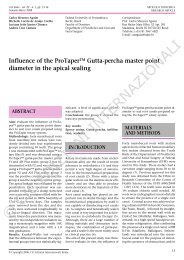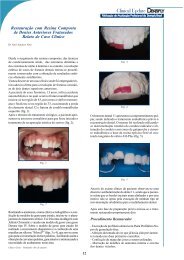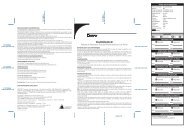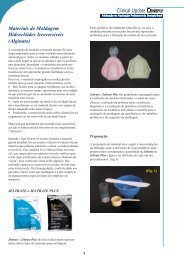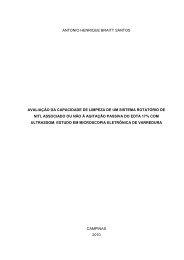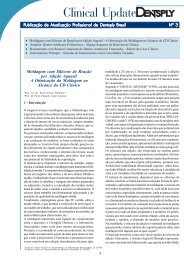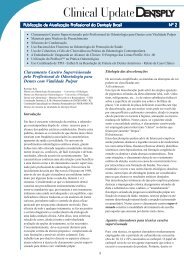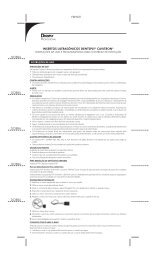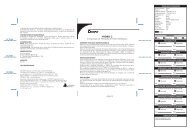Create successful ePaper yourself
Turn your PDF publications into a flip-book with our unique Google optimized e-Paper software.
Söderholm<br />
Fig 1 Sevriton and Severiton Cavity seal were products developed<br />
by the DeTrey/Amalgamated Dental Company. Sevriton Cavity<br />
Seal was the first product claimed to be able to bond to tooth<br />
tissues. 29 This product was developed by the Swiss chemist,<br />
Oskar Hagger.<br />
the fact that microscopic porosities enhanced the retention<br />
of dental materials. What he did not communicate clearly,<br />
though, was that by replacing a brittle cement layer with a<br />
ductile material, the bonding ability could be substantially<br />
enhanced. The latter fact was probably the reason why the<br />
acid etching technique resulted in a major breakthrough in<br />
dentistry when compared to previous approaches to bonding<br />
to teeth.<br />
However, when it comes to a ductile interface, Buonocore<br />
was not the first to use a ductile resin layer at the tooth surface<br />
in order to enhance retention. The first one who came<br />
up with that idea was a Swiss chemist, Oskar Hagger. Hagger<br />
worked for DeTrey/Amalgamated Dental Company, and<br />
had already in 1949 developed an adhesive product called<br />
Sevriton Cavity Seal 33 (Fig 1). This product consisted of glycerolphosphoric<br />
acid dimethacrylate and was intended for<br />
use as an adhesive for the chemically cured resin Sevriton.<br />
Sevriton Cavity Seal was indeed a revolutionary product, because<br />
it was the first product that claimed to be able to<br />
chemically bond to tooth structure. In an article published by<br />
Kramer and McLean in 1952, 29 these two investigators<br />
claimed that the glycerolphosphoric acid dimethacrylate of<br />
the Sevriton Cavity Seal increased the adhesion to dentin by<br />
penetrating the surface. Today we call the resin-penetrated<br />
zone the hybrid zone. This is also remarkable, because we<br />
often assume that hybridization is a more recent discovery<br />
than it obviously is.<br />
The year after Buonocore published his classic paper, he<br />
also published a paper with Brudevold and Wileman, 13 in<br />
which they evaluated Sevriton Cavity Seal and Sevriton. In<br />
that paper they claimed that the glycerolphosphoric acid<br />
dimethacrylate did not bond as well to enamel as a self-curing<br />
resin placed in intimate contact with a phosphoricacid–etched<br />
enamel surface did. However, when placed in<br />
contact with dentin, the glycerolphosphoric acid dimethacrylate<br />
provided some dentin bond enhancement.<br />
Considering Hagger’s fundamental work, there is no<br />
doubt that modern dental adhesive technology had its root<br />
in the late 1940s, when Hagger initiated the use of acidic<br />
monomers to achieve bonding to both enamel and dentin.<br />
What Buonocore really showed was that it was easier to<br />
achieve bonding to enamel than to dentin, something we all<br />
agree upon today.<br />
Even though Buonocore had proved that enamel bonding<br />
worked in 1955, 15 it would take until the late 1970s before<br />
enamel bonding became generally accepted. The turning<br />
point occurred when 3M sponsored the International Symposium<br />
on Enamel Etching in December of 1974. 38 During<br />
that symposium, researchers and clinicians with experience<br />
of enamel bonding presented their findings, and 3M published<br />
and distributed that information to academic institutions<br />
and opinion leaders.<br />
The idea to develop a resin system capable of bonding to<br />
dentin did not die with Hagger. Instead, Bowen, after his invention<br />
of modern composites, focused on dentin adhesives<br />
during the 1960s. During that decade, he formed work<br />
groups that outlined strategies for developing new dental adhesives.<br />
7-11 Guiding principles during these discussions<br />
were: (a) dentin is a vital tissue and should not be exposed<br />
to strong acids, (b) the presence of water should be minimized,<br />
because water would shield bond sites of adhesive<br />
molecules, (c) the adhesive molecules should be at least bifunctional<br />
so one end could bond to tooth surface and the<br />
other to the resin of the composite.<br />
As a result of Bowen’s research, NPG-GMA (N-phenylglycine<br />
and glycidyl methacrylate) was introduced in 1965 as<br />
a potential dentin adhesive. The shear bond strength of this<br />
first generation adhesive was 1 to 3 MPa, and it soon became<br />
obvious that these products did not work clinically.<br />
During the late 1970s, new dentin adhesives were developed.<br />
Most of these products contained of bis-GMA/HEMA<br />
resins mixed with halophosphorous esters. The bonding<br />
mechanism of these adhesives was believed to be due to<br />
ionic bond formation between halophosphorous groups and<br />
calcium ions of the tooth surface. Even though these second<br />
generation products were significant improvements compared<br />
to the first generation products, they still did not result<br />
in clinical success.<br />
A major breakthrough occurred in 1979, when Fusayama<br />
and his coworkers presented their findings, claiming they<br />
could bond to acid-etched dentin without any significant<br />
problems with pulp reactions. 22 The paper was met with ample<br />
skepticism by authorities in pulp biology who argued<br />
that the acidity would cause pulp inflammations and even<br />
pulp necrosis. Fusayama, on the other hand, argued that his<br />
findings were just supporting Brännström and Nyborg’s<br />
claim that bacteria rather than acid was the key concern<br />
when it came to causing pulp damage. 12<br />
Another important paper from Japan came in 1982,<br />
when Nakabayashi and coworkers published their paper<br />
“The promotion of adhesion by the infiltration of monomers<br />
into tooth substrates”. This paper presented the hybrid-layer<br />
formation theory. 35<br />
The findings from Fusayama’s and Nakabayashi’s groups<br />
228 The Journal of Adhesive Dentistry



